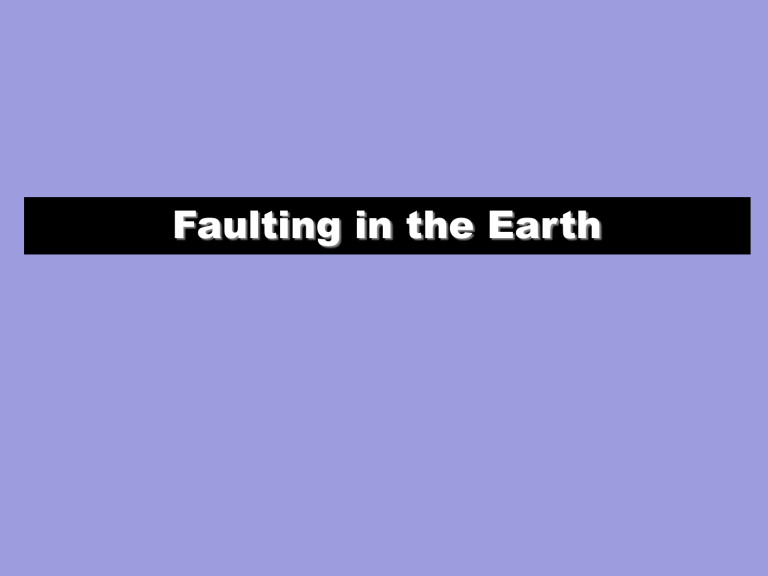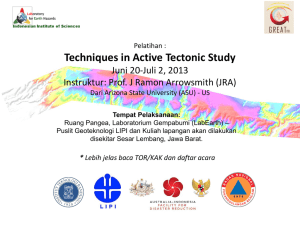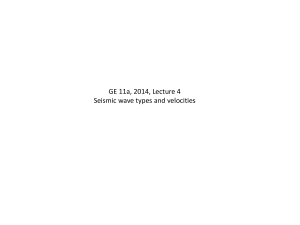Focal Mechanisms and Moment Tensors

Faulting in the Earth
Earthquake rupture can be described in a few ways
36 mm/yr NORTH
AMERICA
PACIFIC
San Andreas Fault, Carrizo Plain
(1) Geometrically: angles or vectors describe the fault orientation and slip direction.
(2) Graphically: focal mechanisms describe two possible fault orientations and slip directions.
(3) Mathematically: moment tensors describe an oriented forces that mimics the rupture physics and can provide a moment magnitude
Fault Geometry Represented Geometrically
Three angles : strike
, dip
, slip
, or
Two orthogonal vectors : fault normal n and slip vector d
Kanamori and Cipar, 1974
Treating the fault as rectangular, the dimension along strike is the fault length and dimension in the dip direction is the fault width.
Slip Angle
Characterizes Fault Type
Most earthquakes consist of some combination of these motions, and have slip angles between these values
P-wave Energy Radiation
Map View of a Strike-Slip Fault
Lithosphere deforms elastically before fault slip
Then the fault slips and the stored elastic energy is released as traveling wave energy
P-wave Energy Radiation
Map View of a Strike-Slip Fault
X1
X2
Around an earthquake, the first motion of the radiated wave is either compressional or dilatational.
P-wave radiation lobes in 3-D
This pattern in the same for all simple faults irrespective of fault orientation
+
-
-
+
Realize that this is a plot of wave energy or amplitude, not the wave itself. The energy travels outward from the earthquake source as a spherical wave .
S-wave energy radiation from a shear plane source
Around an earthquake, the first motion of the radiated spherical wave is polarized either to the left or right relative to path travelled.
Energy radiated to distant stations is usually downward:
Seismic rays bend back up to surface due to velocity increase with depth
Stein & Wysession, 2003
Primary energy to distant stations is radiated out of lower focal hemisphere
Examine the quadrants of a small box about the Earthquake rupture:
Stein & Wysession, 2003
P wave first motions recorded by a seismometer
We know that a P wave has either compressional or dilatational motion depending on the quadrant.
When the P wave arrives at a seismometer from below, a vertical component seismogram records first motion up (compression) or down (dilatation).
First motions can therefore be used to define the four quadrants.
Fault Description: The Focal Mechanism
A depiction of the geometry of faulting based on the radiation pattern of wave energy
Focal mechanisms are determined using a lot of seismometers located all around the earthquake.
Comparison of P-wave energy lobes and focal mechanism in 3-D
P wave first motions recorded by a seismometer
Quadrants are separated by nodal planes: the fault plane and auxiliary plane perpendicular to it.
First motions alone cannot resolve which is the actual fault plane.
To find the fault plane:
Use geologic or geodetic information, such as the trend of the fault or observations of ground motion.
Aftershocks sometimes occur on and thus delineate the fault plane.
If the earthquake is large enough, the finite time required for slip to progress along the fault causes variations in the waveforms observed at different directions from the fault, so these directivity effects can be used to infer the fault plane.
1999 Hector Mine Earthquake (CA)
Magnitude 7.1
FOCAL MECHANISMS FOR BASIC FAULTS
Stein & Wysession, 2003
FOCAL MECHANISMS FOR DIFFERENT FAULTS
All have same N-S striking fault plane, but with varying slip angles
Stein & Wysession, 2003
Simple model predicts faulting on planes 45 ° from maximum and minimum compressive stresses
These stress directions are halfway between nodal planes
Stein & Wysession, 2003
Examples
MECHANISMS show both expected plate boundary deformation
Aleutian Trench: thrust
San Andreas: strike slip
Gulf of California: normal & strike slip
And other boundary zone deformation
Basin & Range: normal
Los Angeles Basin: thrust
LA BASIN
SHORTENING
TRENCH-NORMAL
CONVERGENCE -
ALEUTIAN TRENCH
54 mm/yr
BASIN & RANGE
EXTENSION
PACIFIC wrt
NORTH
AMERICA pole
STRIKE SLIP -
SAN ANDREAS
EXTENSION -
GULF OF CALIFORNIA
Stein & Wysession, 2003
NORTH
AMERICA
EURASIA
EXTENSION
TERCEIRA
RIFT
STRIKE-SLIP
GLORIA
TRANSFORM
NUBIA
OBLIQUE CONVERGENCE
NORTH AFRICA
Argus et al., 1989
NUBIA-SOMALIA SPREADING
Normal fault mechanisms show extension across East African Rift
Seismic Moment Tensors
Seismic Moment Tensor: a general mathematical description of fault rupture
It is a point source mathematical model of an earthquake
Mathematically, a simple earthquake rupture can be described by a FORCE DOUBLE COUPLE
Pearce, 1977
One couple is oriented in the slip direction with forces on opposite sides of the fault plane.
The other is oriented on opposite sides of the auxiliary plane.
We can generalize the double-couple idea to nine possible force couples.
These make up the components of the seismic moment tensor
The nine force-couple values
(“strengths”) can be written into a 3x3 matrix called the Moment
Tensor.
M = M yx
M yy
M yz
M zx
M zy
M zz
The xyz-basis is geographically fixed, combinations of the couples are then used to describe a source of any orientation.
Given the Strike Dip and Rake (or Slip) of a double-couple Earthquake, the Moment Tensor can be determined:
Mxx = −Mo(sinδcosλsin2φ + sin2δsinλsin 2φ)
Mxy = Myx = Mo(sinδcosλcos2φ + sin2δsinλsinφcosφ)
Myy = Mo(sinδcosλsin2φ − sin2δsinλcos2φ)
Mxz = Mzx = −Mo(cosδcosλcosφ + cos2δsinλsinφ)
Myz = Mzy = −Mo(cosδcosλsinφ − cos2δsinλcosφ)
Mzz = Mo(sin2δsinλ)
Φ = strike
δ = dip
λ = rake
Mo = moment
Note: Moment tensors can describe earthquake rupture that is more complicated than the simple focal mechanism approach
Icelandic Volcano Dynamics
(sub-glacial)
What type of source would give rise to this closely spaced (in time and space) set of focal mechanisms?
Icelandic Volcano Dynamics
(sub-glacial)
Moment Tensors are used as the source term in numerical simulations of seismic waves.
Global Moment Tensor Web Page http://www.globalcmt.org/
The Global CMT Project involves four main activities:
1.Systematic determination, with a three-to-four-month delay, of moment tensors for earthquakes with M>5 globally, and accumulation of the results in the CMT catalog.
2.Rapid determination of moment tensors for earthquakes with M>5.5 globally and quick dissemination of results ("quick CMTs").
3.Curation of the CMT catalog, which contains more than 25,000 moment tensors for earthquakes since 1976.
4.Development and implementation of improved methods for the quantification of earthquake source characteristics on a global scale.
ACTUAL EARTHQUAKE FAULT GEOMETRIES CAN BE
MUCH MORE COMPLICATED THAN A RECTANGLE
1992 Landers, California Mw 7.3
SCEC Website
1992 Landers, California Mw 7.3
SCEC Website
ACTUAL EARTHQUAKE FAULT GEOMETRIES CAN BE
MUCH MORE COMPLICATED THAN A RECTANGLE
1992 Landers, California Mw 7.3
SCEC Website
EARTHQUAKE MAGNITUDE
Earliest measures use a dimensionless number measured various ways, including:
M
L local (Richter) magnitude
M b body wave magnitude
M s surface wave magnitude
Measured for distant recordings and there is NO direct tie to physics of faulting
Modern Method:
SEISMIC MOMENT
Gives insight into the amount of slip if we know the fault area from aftershocks, geodesy, or other information.
Based on physics of faulting.
These parameters are determined from waveform analysis of the seismograms produced by an earthquake
COMPARE EARTHQUAKES
USING SEISMIC MOMENT
M
0
Magnitudes, moments (dyn-cm), fault areas, and fault slips for several earthquakes
Alaska & San Francisco differ much more than M s implies
M
0 more useful measure
Units: dyne-cm or N-m
A Newton-meter is dimensionally equal to a joule, the SI unit of energy and work.
However, it is not appropriate to express a torque in joules - torque and energy are physically different despite being dimensionally equivalent.
Moment magnitude M w
M w defined from moment and is used to scale the moment so that we can compare moment to the other (more recognizable) scales
Comparison: Moment magnitude M w
Magnitudes saturate:
No matter how big the earthquake m b never exceeds ~6.4
M s never exceeds ~8.4
However:
M w is defined from the moment so it never saturates
Earthquakes of a given magnitude are ~10 times less frequent than those one magnitude smaller.
An M7 earthquake occurs approximately monthly, and an earthquake of M> 6 about every three days.








